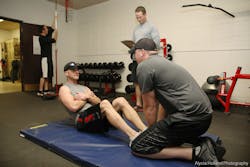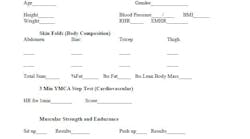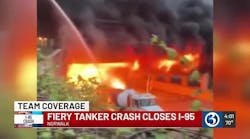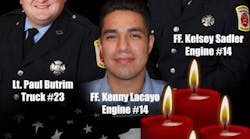We often hear the term “industrial athlete” when describing firefighters—is this term applicable to our chosen career? Of course it is. Professional athletes train their bodies and minds to accomplish extreme feats, and fire service personnel are no different. Athletes and firefighters both must tax their cardiovascular and musculoskeletal systems to perform the tasks at hand while reacting quickly and efficiently, despite the frenetic nature of the situation. A good description of the industrial athlete: Anyone who makes a living using their mental and physical talents to perform a job that requires skill, strength, flexibility, coordination and endurance. The similarity between athlete and firefighter is obvious. The incredible commitment and attention athletes give to their bodies is a commitment shared by firefighters.
It’s 2 a.m., your head finally hits the pillow after 18 hours of running calls, and you’re shaken out of bed by a dispatcher’s voice, advising of a structure fire with people trapped. You jump from your bed and land shortly after in the seat of a fire unit, pulling on 50 pounds of gear. Your vision is limited because you’re wearing a cumbersome SCBA. You arrive at the scene, and you know it’s an emergency situation. Suddenly, you’re pushing, pulling and carrying several hundred pounds of weight. You are forced into an awkward posture because you’re in an unfamiliar, cramped, environmentally unkind atmosphere. You crawl over, under and around obstacles while performing rhythmic breathing in an attempt to preserve air and keep your heart rate down. This is because your heart races to near-maximum levels for uncontrolled periods of time. This is the life of the industrial athlete, the firefighter.
It should be no mystery as to why the rate for occupational injury and death for firefighters is higher than the rate for other occupations. This is why wellness/fitness programs for firefighters should be specifically designed, not only to keep the firefighter well and fit, but to incorporate into the firefighter’s regimen elements such as how to physically move properly. The firefighter, after all, is a human machine that has no control over the environment in which performance occurs.
This we know: Firefighting is one of the most physically demanding and dangerous careers of all civilian occupations. Through wellness/fitness programs, specifically the IAFC/IAFF Fire Service Joint Labor Management Wellness/Fitness Initiative (WFI), we can work to maintain an incredibly valuable resource—the firefighter.
The firefighter’s mission has been, and continues to be, the protection of the general public, but today the mission must also include safeguarding firefighter health. This includes facilitating high fitness levels, so that the professional has the very best chance of being safe and successful in this unpredictable, physically demanding career called firefighting.
Wellness/Fitness programs
The WFI program is designed specifically for incumbent fire service personnel—it is a positive, individualized wellness-fitness program. This program encompasses elements of the National Fire Protection Association (NFPA) 1582 model (health-related fitness programs) and NFPA 1583 (medical evaluations), and similar programs should as well:
- Medical Evaluation (by a physician)
- Fitness Evaluation
- Injury and Medical Rehabilitation
- Behavioral Health
- Cost Justification
- Data Collection
- Implementation
A goal of any firefighter wellness/fitness program should be to improve the quality of firefighters’ lives. This requires passionate, genuine and influential leadership from all levels of department organization—labor, management, fire personnel, the medical/health care team, and trainers. The program should be comprehensive, evidence-based and relevant to the unique demands of the firefighting career. This career, as we know, is different in so many ways from other occupations, many of which have the luxury of leveraging “ergonomic controls” to keep a workforce healthy and injury-free. After all, the work environment of these other occupations is “known”—the environmental control can be designed for the individual worker.
The emergency nature of the firefighting profession actually dictates the firefighter’s work environment—tight and cramped spaces and the carrying of heavy loads, requiring lifting, bending, twisting, pushing and pulling, often from an awkward posture. The firefighter doesn’t have the luxury of choosing where to perform duties, the work environment in which those duties will be performed, or the pace under which those duties will be completed. This is the nature of the work—quick reacting in controlled (and sometimes uncontrolled) chaos. These adrenaline-rushing experiences prompt many instances in which acute stressors are slamming the most vital portions of a firefighter’s system, sometimes over a 20- or 30-year career.
If done correctly, firefighter wellness/fitness programs should carry a professional over a career, and beyond. The mission of these programs, then, should also include a philosophy that firefighters will be healthy and well for as long as possible.
Training firefighters as industrial athletes
When we think of professional athletes, we envision them pushing their bodies to the extreme for hours every day, participating in thorough training in preparation for competition. If we agree that the firefighter is an industrial athlete—a professional athlete, if you will—then this same mindset applies, the firefighter pushing his or her body to the extreme for hours every day, participating in thorough training in preparation for competition—the fire. Like training programs provided to professional athletes, programs for firefighters should feature an integrated approach, with a focus on preventing musculoskeletal and cardiovascular injuries, which can result in life-long disorders or death. And the focus should be on keeping the firefighter healthy on and off the job.
- Download: Exercise Testing Letter for Members
Wellness and fitness initiatives need to be realistic—firefighter injury and death, after all, will occur. But these initiatives also need to underscore for the firefighter this fact: Pursuing professional knowledge and experience is great, but that knowledge and experience won’t make a difference if physical conditioning isn’t achieved. The physical conditioning—or lack thereof—can cost firefighters their lives, or the lives of the citizens we have vowed to protect.
Simply put, fitness needs to be the emphasis, knowing that it is fitness that will keep the firefighter safe and reduce the risk for injury or worse. These fitness philosophies need to include factors recognizing that the firefighter’s body will at times be forced into situations that are not conducive to health.
Injuries occur as “damage that is done” to muscles, tendons, ligaments and bones, when demand (the load applied) exceeds capacity to withstand. (If I apply too much demand on the ligaments in my elbow and my elbow hyperextends or rotates awkwardly, I will have been injured because the demand on my ligaments exceeded the capacity limit of the ligaments themselves.) A goal of any wellness and fitness initiative would be to increase performance and resistance to injury—in other words, to increase the difference between demand and capacity.
Demand and capacity
For health and wellness, we firefighters should train to ensure that our capacity is at its highest achievable level in order to meet the unknown demands of our careers. The fire service, unlike other occupations, is unique when it comes to being able to control the demands of the job (it often can’t be done). Cardiovascular events cause nearly half of firefighter line-of-duty deaths. This is because we don’t have the cardiovascular capacity to meet the demands. The demand (the activity we seek or want to do) is to fight a fire or perform a rescue. Our capacity (our ability) involves strength, endurance, flexibility and motivation. When these capacities aren’t high, we can’t get the job done, and worse, we can become injured or die. In firefighting, bad things happen when demand exceeds capacity. Musculoskeletal injury or cardiac and respiratory occurrences can have lifelong implications. Or end life.
Reduce demand and elevate capacity
One of the most important considerations in reducing demand and ramping up capacity is to improve the way we move during a normal day, either at work or at home. Think about the way we move around during our day at work, the routine things we do on each and every shift. Examples: Donning an SCBA or pulling a fan off of a truck for morning truck checks. What if we use bad ergonomics (twisting and awkward angles) to accomplish these daily tasks? How many times would we have to do this before we sustained a continuous and constant ache in our back? These undesirable movement patterns we repeatedly perform will become rooted habits that may lead to chronic issues. How we move is an important aspect in both our daily activities and the way we exercise. Thinking about how we move is an easy way to reduce demand. Practice makes permanent. Bad practice makes for bad habits.
Keeping simple ergonomics in mind is one way to reduce demand, even when we’re involved in mundane tasks. Keeping healthy during the mundane leaves us prepared for the unexpected—the jobs firefighters perform cannot be modified at the drop of a hat, nor can the demand be removed from the “emergency” we seek to resolve. Wellness and fitness programs for firefighters must include an exercise-specific context in which the frequencies, intensity, times and motion patterns associated with firefighting are acknowledged. Being physically fit and strong likely is not enough.
Fitness is essential, especially for firefighters, but it is not the lone element. The combination of great fitness and great movement provides the firefighter with the best chance of health and survival. Such a framework provides the best chance to avoid demand exceeding capacity. Training and exercise related to movement gives the firefighter better odds when demand ultimately exceeds capacity.
The WFI and similar programs are comprehensive, strategically designed investments in the social, mental and physical health of our most important industrial athlete, the firefighter. These initiatives help to ensure that our firefighters can perform their jobs at optimal levels, and stay healthy and safe, on the job, at home, and well into retirement. We are industrial athletes, but we are also spouses, parents and vital community members. The retention of our health in every way is priority one.
BRIAN DOHERTY has been involved in EMS for over 20 years and joined the career fire service in 1998 as a member of the Butte–Silver Bow Fire Department in Butte, MT. He currently serves as assistant chief/fire marshal. He has been a leader in the department’s fire prevention and public safety programs, serving as a nationally certified child passenger safety technician (NHTSA) and a member of Safe Kid’s Safe Communities worldwide. Doherty has also fully implemented the IAFF/IAFC Joint Labor Management Wellness-fitness Initiative (WFI) within his department that included a $70,000 dollar AFG award. He is active in CISM programs and has a Bachelor of Science in Occupational Safety and Health and is a member of The American Society of Safety Engineers.








